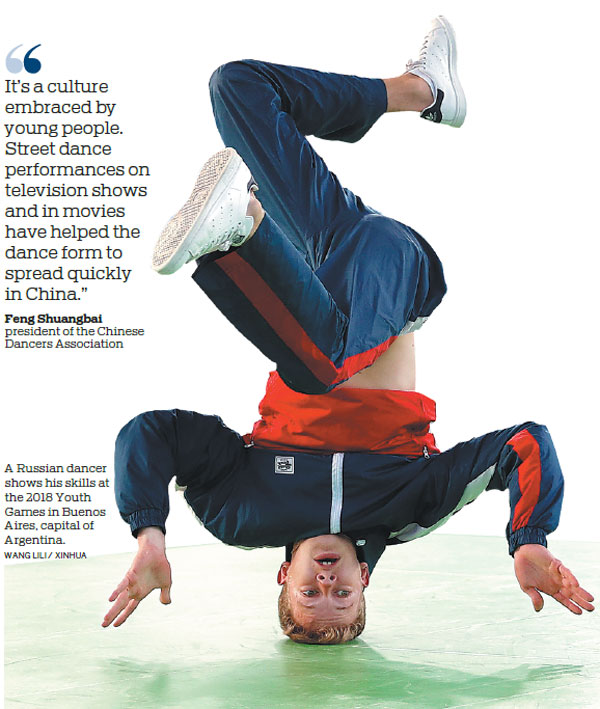STREET DANCERS TURN ON THE STYLE
Skill, creativity and individuality on display
Han Yu's parents used to worry that their son would turn out to be a "bad boy". As a teenager, Han used to spend lots of time dancing to loud music on the streets, clad in baggy outfits.
Now, the 30-year-old has his own dance studio and teaches thousands of students in China, from children to adults, professionals to amateurs.
"I never expected that street dance would become my career, let alone that I'd make a living from it. I just love dancing because it is about self-expression and makes me feel confident," said Han, who was born and raised in Wuhan, Hubei province.

"Nowadays, street dance is accepted in the mainstream and has become a popular culture among people of different ages," he said.
Street dance, or hip-hop dance, originated in the United States in the late 1970s. It includes a variety of styles, such as breaking, locking and popping.
In February, organizers of the 2024 Olympic Games in Paris proposed adding the hip-hop style of break dancing as an Olympic event. The idea was given a trial run at the 2018 Youth Games in Buenos Aires, the capital of Argentina.
In China, street dance has taken root for various reasons, such as internet exposure, high-profile celebrity collaborations and televised competitions. These have led to the dance form finding plenty of enthusiasts.
Han fell in love with hip-hop dance when he was 13 after watching music videos of Michael Jackson and K-pop stars from South Korea, such as the boy band H.O.T. He went to Shanghai to study hip-hop dance when he was 15.
In 2011, Han won in the locking and hip-hop new style categories in the Juste Debout China international street dance competition, which was first held in 2002 in Paris, the French capital. In 2012, he again won in the locking category in the same competition.
"I danced at least eight hours a day. It was encouraging to win those international awards," Han said.
In May, he was crowned champion in the first season of Street Dance of China, a popular online reality show on the video site Youku. Within three months, the number of his Sina Weibo account followers rose from 30,000 to 1 million. Since then, the number has more than doubled to about 2.5 million.
On Aug 18, Han was a torch bearer at the 18th Asian Games in Jakarta, the Indonesian capital.
"I lost 7 kilograms in three months during the reality show. I was exhausted but pleased. I met lots of dancers, both new ones and veterans, who shared a similar vision of street dance as I do. We share love and respect, although the onstage battle is fierce," he said.
After winning the reality show, he turned down opportunities to launch a career as a solo artist, focusing instead on teaching and choreography.
Lu Wei, director of Street Dance of China, said, "China has taken a major leap in street dance compared with years ago, when the major players in international competition came from the United States, Japan and South Korea.
"The dancers are young and creative. In addition to professional hip-hop dancers, there are many people in various occupations, including lawyers and students, who are devoted to it."
The second season of the show will launch next month. Lu said auditions started in October and more than 10,000 dancers from over 100 cities nationwide, ranging in age from 18 to 30, applied to take part in the show.
The four celebrity judges, who include singer-actor Yi Yangqianxi, who is a member of the Chinese boy band TFBoys, and singer-actor Show Lo, led the contestants in competing on a set that resembled an old-fashioned street corner.
In March last year, in addition to Street Dance of China, another reality show, Hot Blood Dance Crew, premiered on the online video platform iQIYI.
Fan base gained
Xia Rui, 37, who was introduced to hip-hop culture as a freshman at Communication University of China in Beijing in 2002, said, "Street dance is blooming in China because the younger generation is eager to express itself." Xia fell for street dance after watching music videos of Michael Jackson and Madonna.
He said that in 2002 few people knew what street dancing was. Xia founded a hip-hop dance community at the university the following year and soon gained a fan base at the school, with nearly 1,000 students joining the group.
"Our teachers and parents considered it a bad influence then. But street dance, which is about skill, creativity and displaying individuality, quickly gained popularity on campus," he said.
"Now, there is a vibrant and fast-developing street dancing scene in China. Like any contemporary art form, street dancing is about using art as a platform for our voices to be heard."
In 2013, the China Hip-Hop Union Committee was founded by the Chinese Dancers Association, and Xia was named its deputy director.
To celebrate Youth Day in China, which falls on May 4, Xia is working on a one-day street dance event by organizing flash mobs in 100 cities.
He said hip-hop dance teaching materials were published by the China Federation of Literary and Art Circles Publishing House in 2015.
Xia, who was born in Xi'an, Shaanxi province, and graduated from CUC with a major in TV and movie directing in 2006, studied for his master's at the university in 2011 and worked at China Central Television before devoting himself to promoting street dance in 2013.
Feng Shuangbai, president of the Chinese Dancers Association, said street dance is no longer just for the few, as witnessed over the past decade.
"It's a culture embraced by young people. Street dance performances on television shows and in movies have helped the form to spread quickly in China," Feng said.
Since the China Hip-Hop Union Committee was founded, more than 30 subcommittees have been launched nationwide.
Last year, the committee brought free street dance classes to more than 600 schools in 164 cities, especially poverty-stricken areas, attracting about 150,000 students. It was supported by the Central Committee of the Communist Youth League and the Chinese Dancers Association.
Xia said that this year the charity program would cover about 2,000 schools in China.
He added that although hip-hop dance has been imported, Chinese dancers have combined it with their own culture, including tai chi, martial arts and local operas.
For example, Xiao Jie, a hip-hop dancer-choreographer from Chengdu, Sichuan province, collaborated with Peking Opera performer Qiu Jirong on a show that combined the iconic character the Monkey King with street dancing in the Spring Festival Gala aired by Beijing Television in early 2017.
Last year, Xia co-choreographed a street dance piece entitled Yellow River, inspired by the Yellow River Cantata by composer Xian Xinghai (1905-45). It won the prestigious Lotus award, the highest dance award in China, in the contemporary dance category.
"When ballet was brought to China, we combined the Western art form with Chinese elements such as the classic ballet piece The Red Detachment of Women. Only when Chinese dancers present their original street dancing choreography works can they be recognized worldwide," Xia said.
There are more than 8,000 registered street dance studios in China, according to the China Hip-Hop Union Committee.
One of the studios is the award-winning RMB Crew, located on the Fifth Ring Road in the east of Beijing.
Gathering together about 100 street dancer-choreographers, RMB Crew launched in 2012. Three years later, it opened its studio, Dance Bank, offering street dance classes to children and adults.
One of the co-founders is street dancer-choreographer Xu Hua, who has worked with singers such as Han Geng and Jay Chou.
Dong Xue, director of the company's marketing department, said, "Some of the students take the street dance classes for fun, while some are sent by entertainment companies and agencies, and are trained to become pop idols."
"We also have child dancers, and some of them go on to become great adult performers," said Dong, who learned street dance in 2004 and became a professional dancer in 2011.
Popularity spreads
While young Chinese see hip-hop as a form of exercise or even a way to earn a living, street dance has also been looked on favorably by parents recently, who allow their children to take it up in their spare time.
Nine-year-old Xue Enqi, who lives in Shanghai, became interested in street dance three years ago and takes classes every week, focusing on locking and breaking.
Her mother, Zheng Shuang, 38, said she has exposed Xue to many art forms since she was about 4. Before she took up street dance, Xue learned piano and jazz dance.
"Since she started taking the classes, she has fallen in love with street dance and wants to become a dancer-choreographer like her teacher," Zheng said.
The popularity of street dance has reached the Xinjiang Uygur autonomous region, which boasts cultural diversity and borders eight countries, including India, Mongolia and Pakistan. The local people have an innate talent for dancing and singing.
One of the street dance pioneers in the region was Firkat Bahadeer, 40, a Uygur who was born and raised in Urumqi, the regional capital. His father, who taught mathematics at Xinjiang University and studied in Japan in the early 1990s, showed Bahadeer a video of Japanese street dancers, introducing him to the dance form.
Bahadeer, who graduated from the law school at Xinjiang University and worked briefly as a lawyer, decided to quit and travel to Shenzhen, Guangdong province, and then to Shanghai in 2001 looking for opportunities to learn with professional street dancers.
He recalls clearly the day he attended a hip-hop party in Shanghai for the first time, after having traveled to the city alone.

"Even before I entered the room I was overwhelmed by the loud music and the hip-hop beat. My body moved to the rhythm, and everything I saw, such as the dancers, the DJs and my reflection in a mirror, seemed like scenes from a slow-motion movie. For someone like me, a young guy from remote Xinjiang, it was like an amazing dream," he said.
In Shanghai, Bahadeer met with Wang Han, a street dancer and choreographer. In 1999, Wang opened a street dance studio, Dragon Dance. Bahadeer started dancing with Wang, and an increasing number of people from Xinjiang traveled to Shanghai to learn the dance form from him. Soon afterward, Bahadeer opened his own street dance studio, DSP (dream, soul and passion) in Urumqi.
This month, Bahadeer, with help from Wang, the head judge of Hip-Hop International China, took the organization's street dance competition to Xinjiang.
In two days, dance lovers from across the region flocked to the city as competitors and spectators.
Hip-Hop International, founded in 2002, has branches in more than 50 countries and regions, all of which send teams to the world championship, which was held in Shanghai three years ago.
"In Urumqi, the event feels more like a festival. In addition to competing in front of the judges at the venue, the streets also become remarkable places for the dancers to practice, communicate and to have fun," Bahadeer said.
chennan@chinadaily.com.cn


(China Daily 04/19/2019 page1)


















